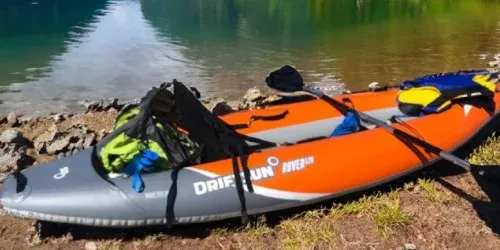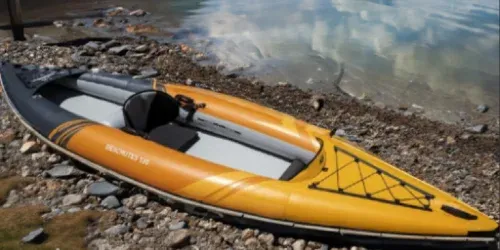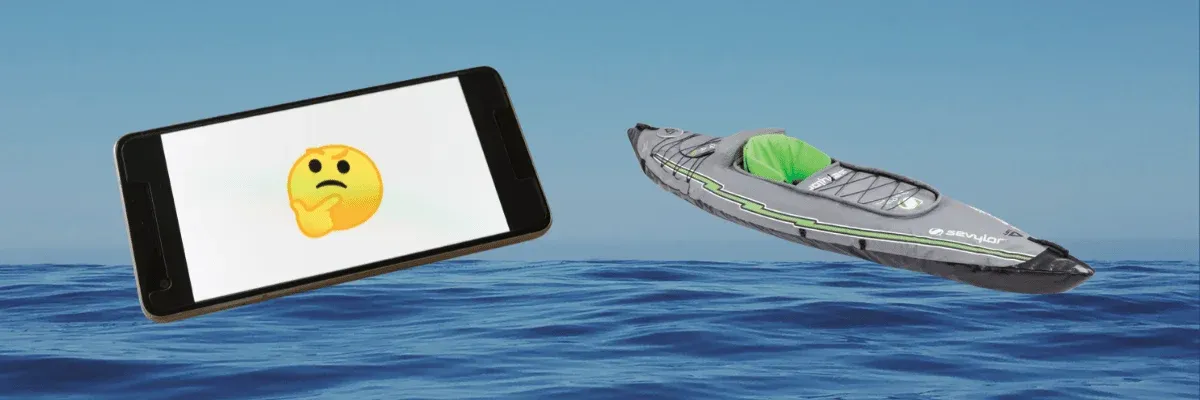Key Takeaways:
- Inflatable kayaks are designed with stability in mind, featuring multiple air chambers and wide bases to reduce the chances of tipping over.
- Modern materials and manufacturing technology have made inflatable kayaks as durable and safe as hardshell kayaks under normal conditions.
- Proper use, including correct inflation and adherence to weight capacity, is crucial for ensuring the safety and stability of inflatable kayaks.

Inflatable kayaks have become increasingly popular among paddling enthusiasts, from beginner kayaker to experienced paddlers. Their portability, ease of storage, and affordability make them an attractive option for many. However, one question often arises: do inflatable kayaks tip over easily? This comprehensive article will delve into the stability and safety of inflatable kayaks, comparing them to their hardshell counterparts and providing practical insights into their use.

Understanding the Stability of Inflatable Kayaks
When it comes to stability, most inflatable kayaks are designed with a wide base, which naturally makes them more stable on the water. Unlike hard shell kayaks, which can be narrow and require more skill to balance, inflatable kayaks often have a flatter bottom that provides a more secure and stable ride. This design feature is particularly beneficial for novice kayakers who are still getting accustomed to the movement of the kayak on the water.
Moreover, modern inflatable kayaks are equipped with multiple air chambers. This not only contributes to the overall buoyancy but also ensures that even if one chamber is compromised, the kayak will stay afloat. The presence of these air chambers makes the inflatable kayak incredibly buoyant, which is a key factor in preventing the kayak from tipping over.
Are Inflatable Kayaks Safe?
Safety is a top priority for anyone on the water, and when it comes to inflatable kayaks, the question of safety often revolves around their ability to resist punctures and stay afloat. Most inflatable kayaks are made from thick coated materials and multiple layers that are resistant to punctures from hooks, rocks, and other sharp objects. These materials are similar to those used in military and commercial inflatable boats, which are known for their durability.
In addition to the robust materials, the construction of inflatable kayaks often includes reinforced seams and a high-pressure drop stitch floor, which not only adds to the rigidity but also enhances the performance of the kayak. When properly inflated to the recommended pressure, an inflatable kayak can be just as rigid and capable of maximum performance as a hardshell kayak.
Comparing Inflatable and Hardshell Kayaks
When comparing inflatable kayaks to hard shell kayaks, it's important to consider the different scenarios in which they are used. Hardshell kayaks are often favored for their performance in rough waters and their ability to cut through waves with ease. However, inflatable kayaks have made significant strides in their design, allowing them to handle various water conditions, including flat water and mild rapids.

Inflatable kayaks also have the advantage of being easier to transport and store. Without the need for roof racks or a large storage space, they can be deflated, folded, and packed away in a carry bag. This convenience is a significant factor for those who have limited space or prefer a kayak that can be easily taken on trips.
The Role of Proper Inflation in Kayak Stability
Proper inflation is critical for the performance and stability of an inflatable kayak. An under-inflated kayak can sag in the middle, affecting its buoyancy and making it more susceptible to tipping. Conversely, over-inflation can cause the kayak to become rigid and uncomfortable, and in extreme cases, lead to air leaks or damage to the kayak.
To ensure the correct inflation level, it's advisable to use a hand pump or foot pump with a pressure gauge. Most inflatable kayak brands provide guidelines on the optimal air pressure for their kayaks. Following these guidelines will help maintain the kayak's shape, provide a comfortable ride, and reduce the risk of tipping over.
Weight Capacity and Its Impact on Stability
Every type of kayak, whether inflatable or hardshell, has a specified weight capacity. Exceeding this limit can greatly affect the kayak's stability and performance. Inflatable kayaks, in particular, rely on an even distribution of weight to maintain their shape and stability on the water.
It's essential to consider not only the weight of the paddler but also any additional gear when calculating the total load. Staying within the recommended weight capacity will ensure that the kayak remains stable and performs as intended, reducing the likelihood of tipping over.
The Evolution of Inflatable Kayak Materials
Have you ever wondered what makes modern inflatable kayaks so resilient? It's all about the evolution of materials. Most inflatable kayaks are now crafted from thick coated materials and multiple layers, which contribute to their durability and resistance to punctures. Unlike the early days of inflatable watercraft, where a single prick could lead to disaster, today's kayaks are made with robust fabrics that can withstand encounters with other sharp objects and rough waters. This advancement in manufacturing technology has significantly reduced the chances of an inflatable kayak sink scenario.
Moreover, the use of high-pressure drop stitch technology in some inflatable kayak categories has revolutionized their performance. This technique allows for a much firmer inflated kayak, providing a level of rigidity comparable to hardshell kayaks. The air chambers in these kayaks can be inflated to a higher pressure, resulting in a more stable and efficient ride. This means that when you're out sea kayaking or riding waves, your inflatable kayak remains incredibly buoyant and less likely to tip over, ensuring that kayaks are not just safe, but perfectly safe for your aquatic adventures.
Enhancing Stability: The Science Behind Inflatable Kayak Design
Have you ever wondered why most inflatable kayaks seem to have a knack for staying upright, even in choppy waters? It's not just a stroke of luck; it's science at work. Modern inflatable kayaks are designed with multiple air chambers, which not only make them incredibly buoyant but also provide a safety net in the unlikely event of an air leak. These chambers are strategically placed to distribute weight evenly and lower the kayak's center of gravity, making it harder for the kayak to tip over.
Moreover, the manufacturing technology of inflatable kayaks has come a long way. High-pressure drop stitch materials allow for a more rigid structure, akin to that of hardshell kayaks, which contributes to maximum performance and stability. This means that when you're out on flat water or riding waves, the kayak maintains its shape and minimizes the tipping point, allowing both beginner kayaker and experienced paddlers to enjoy their time on the water without the constant fear of capsizing.

The Unsung Heroes: Accessories That Aid Kayak Stability
When it comes to inflatable kayaking, accessories aren't just add-ons; they're integral components that can significantly enhance stability. For instance, a tracking fin, often overlooked, can be a game-changer. It attaches to the bottom of the kayak and helps in maintaining a straight path, reducing the effort needed from your upper body and thus lowering the risk of tipping over. This is especially useful for novice kayakers who are still mastering their paddle technique.
Another accessory that can make inflatable kayaks good companions in rough waters is the spray skirt. Designed for sit in kayaks, a spray skirt keeps you dry and adds an extra layer of stability by preventing water from filling the cockpit. For those who venture into sea kayaking, this can be the difference between staying afloat and finding yourself in a precarious situation. And let's not forget about the life jacket – it doesn't directly affect the kayak's stability, but it's a critical safety accessory that ensures you stay safe, even if you do end up in the water.
Inflatable Kayaks and Advanced Safety Features
When it comes to safety, modern inflatable kayaks are equipped with features that make them incredibly safe for paddlers of all levels. For instance, multiple air chambers are a standard design aspect now. Why does this matter? Well, if one air chamber happens to suffer an air leak, the remaining chambers stay afloat, which greatly reduces the risk of the kayak tipping over. This design is particularly reassuring for beginner kayaker enthusiasts who might be concerned about the kayak's stability in the event of an accident.
Additionally, many inflatable kayaks come with self-bailing capabilities. This means that any water that gets into the kayak can drain out automatically, helping to maintain stability and prevent accidents. Some models also include a tracking fin, which aids in keeping the kayak straight as you paddle, making it less likely to tip over. And let's not forget about the spray skirt, which can be found on some sit in kayaks, adding an extra layer of protection against splashes and waves. With these advanced safety features, it's clear that modern inflatable kayaks are designed not just for maximum performance but also for ensuring that every paddling experience is as safe as it can be.
Maneuvering and Paddling Techniques to Prevent Tipping
The way a paddler handles the kayak can also influence its stability. Paddling techniques, such as maintaining a low center of gravity and using smooth, even strokes, can help prevent the kayak from becoming unbalanced. Additionally, when turning or navigating through waves, it's important to lean into the turn and paddle hard to maintain stability.
For tandem kayaks, coordination between paddlers is crucial. Synchronized paddling and clear communication can help keep the kayak stable and prevent any sudden movements that might cause it to tip.
The Importance of a Repair Kit and How to Use It
Despite the durability of inflatable kayaks, accidents happen. A small puncture or air leak can occur if the kayak comes into contact with a sharp rock or other sharp objects. Carrying a small patch kit is a simple yet effective way to address any unexpected issues on the water.
Most repair kits include patches and adhesive that can be applied to the damaged area. It's important to follow the manufacturer's instructions for the best results. A properly applied patch can extend the life of the kayak and ensure that it remains safe and stable for future adventures.

Selecting the Right Inflatable Kayak for Stability
When choosing an inflatable kayak, it's important to consider the specific features that contribute to its stability. Look for kayaks with wide bases, multiple air chambers, and a high weight capacity. Additionally, consider the type of kayaking you plan to do—whether it's recreational kayak on calm lakes or sea kayaking along coastlines.
Reputable brands often provide detailed information about their kayaks, including the materials used, construction methods, and design features that enhance stability. Reading reviews and comparing different models can help you select an inflatable kayak that meets your stability and safety needs.
Accessories That Enhance Kayak Stability
There are several accessories available that can further enhance the stability of an inflatable kayak. A tracking fin, for example, can help the kayak maintain a straight course, reducing the effort needed to paddle and the risk of tipping. Similarly, a spray skirt can protect against water splashing into the kayak, which can affect its buoyancy and stability.
For those who enjoy riding waves or navigating rougher waters, self-bailing kayaks with built-in drainage systems can help manage water that enters the kayak, keeping it stable and afloat.
The Role of Experience in Kayak Stability
Experience plays a significant role in the stability of any kayak. Experienced paddlers are more adept at reading the water, handling their kayak, and reacting to changing conditions. They understand the tipping point of their kayak and how to adjust their body and paddling technique to maintain stability.
For beginner and novice kayakers, it's advisable to start on calm, flat water and gradually build up to more challenging conditions. Taking a kayaking course or seeking guidance from experienced paddlers can also help improve skills and confidence on the water.

Summary
Inflatable kayaks have come a long way in terms of design, materials, and construction, making them a stable and safe option for paddlers of all levels. While they can tip over, the likelihood is reduced by their wide bases, multiple air chambers, and proper use. By selecting the right kayak, adhering to weight limits, using correct paddling techniques, and being prepared with a repair kit, paddlers can enjoy a stable and enjoyable kayaking experience with an inflatable kayak.

FAQs
Can inflatable kayaks handle rough waters?
Yes, modern inflatable kayaks with advanced design features can handle mild to moderate rough waters. However, it's important to choose a kayak that is suited for the specific water conditions and to have the necessary skills to navigate safely.
How do I know if my inflatable kayak is properly inflated?
Most inflatable kayaks come with recommended air pressure guidelines. Using a pump with a pressure gauge and following the manufacturer's instructions will ensure proper inflation. The kayak should feel firm to the touch but not overly rigid.
Are inflatable kayaks as durable as hardshell kayaks?
With advancements in manufacturing technology and materials, inflatable kayaks can be just as durable as hardshell kayaks. They are made with thick coated materials and multiple layers to resist punctures and provide a long lifespan when cared for properly.









